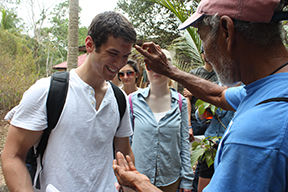Students enrolled in the Rainforest Ethnobotany Experiential Learning Adventure to Belize at Penn State Berks traveled to Belize from May 5?15, 2013, along with Dr. Aisha Jaffri, instructor in biology, to learn how plants from the rainforest can be used to treat a variety of illnesses.
Six seniors participated in the trip, including Kristine Feick, Rebecca James, Abdullah Naeem, Andrew Salamak, Dewilka Simons, and Nathaniel Tschudy.
"The standard classroom lecture format is not an ideal environment for teaching medicinal plant application,? explains Jaffri. ?The students gained firsthand knowledge of the medicinal properties of plants in the rainforests and biodiversity regions of Belize. This demonstrated a tremendous value to our students as they explored the history, culture, and geography of the areas visited.?
The class teamed up with pharmacy, medical, and naturopathic students through the Student Rainforest Fund, a nonprofit, educational organization that raises funds to help underwrite expeditions to the world?s rainforests for college students who are studying the health professions. The students learn about medicinal plants, herbs, and botanicals in the world?s greatest pharmacy?the rainforest. They also work closely with indigenous healers in the field, learn about the ecology of the country and the need for fostering environmental stewardship, and get a more holistic approach to healing and medicine that could never be taught in the classroom.
?The students gained an invaluable international perspective by working with indigenous healers such as "Elijio Panti," the famous Mayan shaman from Belize whose medicine trail we all walked through at the Ix Chel Tropical Research Centre. They also met with two members of the Belizean Traditional Healers Association, Mr. Polo Romero (bushmaster) and Mrs. Juana Sish (mid-wife). Furthermore, the students were exposed to a different approach to medicine rather than traditional routes. Exposing students to unique practitioners early in their college career can perhaps influence which career path is appropriate for them," comments Jaffri.
During their time in Belize, the students also had time to visit many sites including the ?Panti Greene Medicine Trail;? Tikal, the ancient Mayan ruin in Guatemala; Frias Fall; Xuantunich Mayan Ruin; the largest ruin in Belize; the Toledo District of Belize and the coastal city of Punta Gorda; the islands in the Western Hemisphere?s largest coral reef; and Payne?s Creek National Park.
?The trip gave light to a completely different side of medicine, which is commonly overlooked,? states Naeem. ?Also, the trip demonstrated how crucial rainforests are in our world by providing several species of plants that may serve for medicinal purposes.?
"The expedition to Belize was truly enlightening,? adds Tschudy. ?From a scientific and medical perspective, my mind was opened to the importance of embracing, preserving, and most importantly sharing the valuable heritage of natural Mayan medicine. From a cultural perspective, I cannot begin to express the beauty of the Belizean spirit. This expedition will remain in my heart and mind for a lifetime."
Jaffri is in the process of planning next year?s excursion, in which the students may visit the Vilcabamba Valley in Ecuador.
For more information, contact Jaffri at 610-396-6390, extension 3160 or via e-mail at AXJ120@psu.edu.
